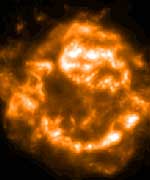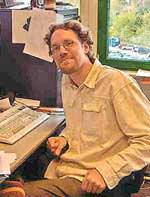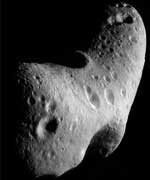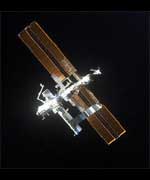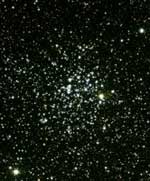
Image credit: NOAO/AURA/NSF
Monday, November 29 – With a short time until the Moon rises tonight, why not journey with me once again to Cassiopeia? We will start our studies with the western-most of the bright stars – Beta. Also known as “Caph”, Beta Cassiopeiae is approximately 45 light years away and known to be a rapid variable. Viewers with larger telescopes are challenged to find the 14th magnitude optical companion to Caph at about 23″ in separation. Tonight, using our previous study star Alpha and Beta, we are going to learn to locate a Messier object with ease!
By drawing an imaginary line between Alpha and Beta, we extend that line the same distance and angle beyond Beta and find the M52. Found on September 7, 1774 by Charles Messier, this magnitude 7 galactic cluster is easily seen in both binoculars and small telescopes. Comprised of roughly 200 members, this open cluster is roughly about 3,000 light years in distance and spans approximately 10-15 light years. Containing several different magnitudes, larger telescopes will easily perceive blue components as well as orange and yellow. The M52 (NGC7654) is a young, very compressed cluster whose approximate age is about the same as the Plieades. For those with large telescopes wanting a challenge? Try spotting a faint patch of nebulosity just 36′ to the southwest. This is the NGC7635, more commonly known as the “Bubble Nebula”. Best of luck!
Tuesday, November 30 – Tonight the Moon will be at apogee, or its greatest greatest distance from Earth. For those of you staying up late it will form a nearly straight line with Castor and Pollux with Saturn below and to the right. For those preferring to take your astronomy at an earlier hour? We’ll be delighted that the Moon will be out of the way for several hours as we adventure further into Cassiopeia! Returning the Cassiopeia’s central-most star – Gamma, tonight we will move towards the southeast and identify Delta. Also known as Ruchbah, this long-term and very slight variable star is about 45 light years away, but we are going to use it as our marker as we head just one degree northeast and discover the M103. As the last object in the original Messier catalog, the M103 (NGC581) was actually credited to Mechain in 1781. Easily spotted in binoculars and small scopes this rich open cluster is around magnitude 7, making it a prime study object. At about 8000 light years away and spanning approximately 15 light years, the M103 offers up superb views in a variety of magnitudes and colors, with a notable red in the south and a pleasing yellow and blue double to the northwest.
Telescopes and larger binoculars viewers are encouraged to move about a degree and half east of M103 to view a small and challenging chain of open clusters, the NGC654, NGC663 and NGC659! Surprisingly larger than the M103, NGC663 is a lovely fan-shaped concentration of stars with about 15 or so members that resolve easily to smaller aperture. For the telescope, head north for NGC654, (difficult, but not impossible to a 114mm scope) who has a bright star on its’ southern border. South of NGC663 is the NGC659 which is definitely a challenge for small scopes, but its presence will be revealed just northeast of two conspicuous stars in the field of view.
Wednesday, December 1 – What better way to start a new month than to get up early to see four planets and the Moon?! Just before dawn, the waning gibbous Moon will appear in the sky just above Saturn with the Gemini “Twins”, Castor and Pollux, to the west. Below and to the east of bright Luna is the mighty Jupiter, and you will find Venus and Mars slow dancing together near the horizon. What a fine show!
While Cassiopeia is still fresh in our minds, let’s return again tonight for some additional studies. Starting with Delta, let’s hop to the northeast corner of our “flattened W” and identify 520 light year distant Epsilon. For larger telescopes only, it will be a challenge to find 12″ diameter, magnitude 13.5 planetary nebula I.1747 in the same field with magnitude 3.3 Epsilon!
Using both Delta and Epsilon as our “guide stars” let’s draw an imaginary line between the pair extending from southwest to northeast and continue the same distance until you stop at visible Iota. Now go to the eyepiece! As a quadruple system, Iota will require a telescope and a night of steady seeing to split its three visible components. Approximately 160 light years away, this challenging system will show little or no color to smaller telescopes other than white, but to large aperture, the primary may appear slightly yellow and the companion stars a faint blue. At high magnification, the 8.2 magnitude “C” star will easily break away from the 4.5 primary 7.2″ to the east/southeast, but look closely at that primary.. hugging in very close (2.3″) to the west/southwest and looking like a “bump” on its side is the B star!
Dropping back to the lowest of powers, place Iota to the southwest edge of the eyepiece, it’s time to study two incredibly interesting stars that should appear in the same field of view to northeast. When both of these stars are at their maximum, they are easily the brightest of stars in the field. Their names are SU (southernmost) and RZ (northernmost) Cassiopeiae and both are unique! SU is a pulsing Cepheid variable located about 1000 light years away and will show a distinctive red coloration. RZ is a rapidly eclipsing binary that can change from magnitude 6.4 to magnitude 7.8 in less than two hours. Wow!
Thursday, December 2 – Once again utilizing early darkness, let’s go back to Cassiopeia. Remembering Alpha’s position as the westernmost star, go there with your finder scope or binoculars and locate bright Sigma and Rho (who both have a dimmer companion) and will appear to the southwest. It is between these two stars that you will find the NGC7789.
Absolutely one of the finest of rich galactic opens bordering on a loose globular, the NGC7789 has a population of about 1000 stars and spans a mind-boggling 40 light years. At well over a billion years old, the stars in this 5000 light year distant galactic cluster have already evolved into red-giants or super-giants. Discovered by Caroline Herschel in the 18th century, this huge cloud of stars has an average magnitude of 10, making it a great large binocular object, superb small telescope target, and a total fantasy of resolution for larger instruments.
Friday, December 3 – Tonight we will haunt Cassiopeia one last time – for the seasoned observer. Our first challenge of the evening will be to return to Gamma where we will locate two patches of nebulosity in the same field of view. The IC59 and IC63 are challenging because of the bright influence of the star, but by moving the star to the edge of the field of view you may be able to locate these two splendid small nebulae. If you do not have success with this pair, why not move on to Alpha? About one and a half degrees due east you will find a small collection of finder scope stars that mark the area of NGC281. This distinctive cloud of stars and ghostly nebula make this NGC object a fine challenge!
The last we will study will be two small elliptical galaxies that are achievable in mid-sized scopes. Locate Omicron Cassiopeiae about 7 degrees north of the M31 and discover a same field of view galactic pair that is associated with the Andromeda group, NGC185 and NGC147.
The constellation of Cassiopeia contains many, many more fine star clusters, nebulae and even more galaxies. For the casual observer, simply tracing over the rich star fields with binoculars is a true pleasure, for there are many bright asterisms best enjoyed at low power. Scopists will return to “rock with the Queen” year after year for its many challenging treasures. Enjoy it tonight!
Saturday, December 4 – It’s a comet hunter’s night… Are you ready? Then let’s be glad we have several hours until the Moon rises tonight so we have an opportunity to locate and view these fine comets!
If you were able to spot NGC654 and NGC659, earlier in the week, then you’ve got what it takes to find C/2004 Q1 (Tucker)! Holding an estimated magnitude 10.5, it is possible to see this comet with large binoculars and small telescopes. You will find Comet Tucker cruising through Andromeda just a bit southwest of M31.
Before Southern Hemisphere viewers begin to feel left out, why don’t we try chasing a comet tonight viewable to both of us? Comet 78P/Gehrels has an estimated magnitude of 10.7, putting it within range of most large binoculars and small telescopes. You will find it at the corner southern corner of the Aries/Taurus border, but it will be moving through Aries on this date and nearer to the border of Cetus and not too far from Lambda.
Next up is a comet suitable for mid-size to large aperture telescopes. Comet 29P/Schwassmann-Wachman will be at an estimated magnitude 12 but is beginning to fade. At this time you may be able to see about 55″ of coma! The hunting directions for 29/P show that it’s located on the Pegasus/Pices border and roughly halfway between 80 Pegasus and 26 Pices.
Northern viewers? Break out the big muscle for C/2001 Q4 (NEAT). At an estimated magnitude 12, it can be found in Draco buzzing along just south of Psi and a bit north of Omega. While you’re there, head on south to Iota and see if you can locate C/2003 T4 (LINEAR). At a rough magnitude of 12.5, T4 will sport a slight coma of 1.7″ and is moving west just slightly south of Iota.
How about one more? Then let’s go for 32P/Comas Sola. With an estimated magnitude of 12 with a slight coma of 1.1′, 39P has now moved into Aries and can be found just slightly northwest of Mu Cetii. Talk about some great challenges… I’ll race you there!
Sunday, December 5 – Although no one likes to get up early in the morning, you might find the trip quite worth it to see Mars and Venus together in the pre-dawn skies. The fat and gibbous Venus will make a splendid contrast with tiny, dusty red Mars as they stand together in the skies at just slightly more than one degree apart.
(We’re a little “uncertain”, but we do believe Werner Heisenberg was born on this day in 1901.)
Until next week? Keep looking up and enjoying the wonders of the Cosmos! Wishing you clear skies and light speed… ~Tammy Plotner
